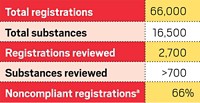Advertisement
Grab your lab coat. Let's get started
Welcome!
Welcome!
Create an account below to get 6 C&EN articles per month, receive newsletters and more - all free.
It seems this is your first time logging in online. Please enter the following information to continue.
As an ACS member you automatically get access to this site. All we need is few more details to create your reading experience.
Not you? Sign in with a different account.
Not you? Sign in with a different account.
ERROR 1
ERROR 1
ERROR 2
ERROR 2
ERROR 2
ERROR 2
ERROR 2
Password and Confirm password must match.
If you have an ACS member number, please enter it here so we can link this account to your membership. (optional)
ERROR 2
ACS values your privacy. By submitting your information, you are gaining access to C&EN and subscribing to our weekly newsletter. We use the information you provide to make your reading experience better, and we will never sell your data to third party members.
Economy
How Europe’s chemical industry learned to love REACH
Supporting the chemical management law is good for competitiveness, Europe’s chemical industry now says
by Alex Scott
July 16, 2018
| A version of this story appeared in
Volume 96, Issue 29

The European Chemical Industry Council (Cefic), Europe’s leading chemical industry association, has made a U-turn in its view of REACH, Europe’s Registration, Evaluation, Authorisation & Restriction of Chemicals legislation. After years of kicking and screaming to resist REACH—the biggest and most expensive body of chemicals regulation ever introduced—Cefic has emerged as its biggest advocate.
Cefic Director General Marco Mensink and his colleagues now argue that if chemical firms around the world buy into a REACH-style system, which requires safety data on individual substances, then European chemical firms will be able to show that their products are among the safest and should face fewer barriers to trade.
This attitude marks an about-face in Cefic’s approach to REACH, industry critics say. REACH was conceived in the 1990s as a way to regulate chemicals in the European Union and encourage substitution of dangerous substances. It entered into force on June 1, 2007, and is administered by the European Chemicals Agency, or ECHA.
“When the concept of REACH was introduced, there was an element of scaremongering on the industry side,” recalls Axel Singhofen, adviser on health and environment policy for both the Green Party and the European Free Alliance party in the European Parliament.
That may be, but Cefic is keen to leave such history behind. “Going in peace might not be the worst way for the industry and the European Chemicals Agency to go together,” Mensink told delegates recently at the Helsinki Chemicals Forum, a meeting on European chemicals regulation.
The heads of Cefic and ECHA formalized their positions at the Helsinki meeting by agreeing to an alliance on REACH. They signed a joint agreement to cooperate further on improving the implementation of REACH by sharing chemical safety data and striving to improve the scientific assessment of some substances.
A key benefit of the alliance for industry is ECHA’s agreement to bring its experts and those from industry together to discuss critical issues about a substance ahead of any regulatory decision or ECHA opinion.
The alliance was formed just weeks after the May 31 deadline for chemical companies in Europe to register hazard data on thousands of chemicals they produce in volumes of 1 to 100 metric tons per year. The deadline, the third of three, marks the completion of the regulation’s multi-billion-dollar, 10-year program of data gathering for more than 21,000 existing chemicals.
Cefic hopes the alliance will lead to a streamlining of the process of registering chemicals under REACH, making it more straightforward for companies outside Europe to adopt. Meanwhile, ECHA is encouraging regulators outside the EU to adopt their own REACH-style chemical management systems.
The U.S. is one country that is not about to join the REACH hug-in. Mensink pointed out that at last month’s annual meeting of the American Chemistry Council, the main trade association for the U.S. chemical industry, CEO Cal Dooley hailed the U.S. regulatory environment as a key competitive advantage over Europe.
Advertisement
The Toxic Substances Control Act, the central piece of U.S. chemical regulation, is less prescriptive than REACH. It also fits with President Donald J. Trump’s desire for a light touch in the regulation of business.
Indifference to REACH by the U.S. wasn’t the only gripe Mensink aired. Promoting the regulation in other parts of the world also faces challenges, he said. One problem is that REACH has plenty of detractors in its own backyard. Some European member states fail to acknowledge that REACH ensures product safety, he said.
“Not everyone is yet on board,” Mensink said. “Not everyone likes the way industry operates. Member states should support the outcome of REACH.”
The Cefic leader also took aim at environmental groups that publish alternative lists of chemicals to those recognized as substances of very high concern under REACH. These are a distraction and undermine REACH, Mensink said. “Don’t make alternative lists,” he warned.
For REACH is to be highly regarded around the world, public criticism of the chemical data dossiers that companies submit to ECHA also needs to stop, Mensink said. Rather, ECHA should give industry “a few years” to ensure all the data dossiers meet the required standard before ECHA reviews them, he said.
Mensink’s wish list extends to the education of other countries by the European Commission on the benefits of REACH. “We need a smart foreign REACH policy,” he said. “The EU should put some money on the ground to explain what REACH is.”
If chemical companies from outside Europe are to take REACH seriously, better enforcement is needed to ensure that chemicals imported into the EU comply with the regulation. “You have to make sure you enforce it, following up with checks at borders. There is no benefit for the REACH brand if we comply in Europe but do not do checks on imports,” Mensink said.
ECHA acknowledged some of Mensink’s points, albeit with a less combative tone. Bjorn Hansen, ECHA’s recently appointed executive director, highlighted the need to work with the European chemical industry to promote a competitive environment and encourage innovation through REACH. One way ECHA could facilitate such competition is by working with industry to identify at a far earlier stage whether a new or existing substance is toxic, he said.
ECHA is also looking at ways to make the data generated under REACH more usable for industry. One example is improving the usability of safety data sheets, which stipulate how certain substances should be managed and handled, Hansen said.
Whether REACH or REACH-like standards make their way beyond Europe’s borders ultimately may be out of the hands of Cefic and ECHA and instead in those of the banking sector. Banks increasingly will require chemical firms building new plants to have first-class compliance with regulatory systems and environmental standards—such as REACH—in place, said David Williamson, associate director and head of environment and sustainability for the European Bank for Reconstruction & Development, speaking at the event.
Cefic, though, isn’t relying on the banks. It is urging the EU to encourage chemical regulators around the world—especially China, with its huge chemical industry—to adopt REACH-style regulations. The introduction of a communications center for REACH in China, as proposed by industry in Helsinki, may not be far away.




Join the conversation
Contact the reporter
Submit a Letter to the Editor for publication
Engage with us on Twitter